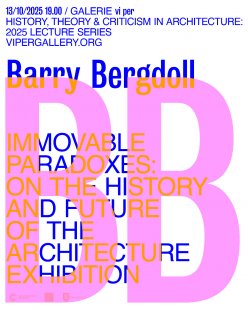
Barry Bergdoll: Immovable Paradoxes - přednáška v Galerii VI PER
On the History and Future of the Architecture Exhibition
Pořadatel
Galerie VI PER
Místo konání
Vítkova 2, Karlín, Praha
Start
mon 13.10.2025 19:00
Odkaz
www.facebook.com ...
Galerie VI PER
Místo konání
Vítkova 2, Karlín, Praha
Start
mon 13.10.2025 19:00
Odkaz
www.facebook.com ...
Lectures
Czech Republic
Prague
Karlín
Publisher
Tisková zpráva
Tisková zpráva
Museums and galleries are increasingly developing thanks to the transportability of the artworks that are exhibited, rearranged, borrowed, change places, and engage in new networks of meaning. Architecture, by its very nature, is the opposite: anchored in its place, often tied to it, and in most cases with a desire for permanence. However, since the early 18th century, a culture of exhibiting architecture has emerged, which often operated in representations and created new possibilities for architectural practice: it stimulated public debate, shaped the history of architecture, amplified discussions about national identity, helping to create conditions for the avant-garde, and expanded the very meaning of architecture itself. In this lecture, Barry Bergdoll offers an overview of a decade-long project examining the history of the exhibition of architecture for an upcoming book titled “Out of Site/In Plain View”. He will draw from his curatorial experiences, particularly at the Museum of Modern Art and the Center for Architecture in New York, to suggest the significance of exhibiting architecture face to face with the challenges of contemporary times, from the global climate crisis to the rise of authoritarian attacks on public opinion and free discussion.
Barry Bergdoll is a professor of art history at Columbia University and served as Chief Curator of the Department of Architecture and Design at the Museum of Modern Art (MoMA) in New York from 2007 to 2013. As a specialist in the history of the 19th and 20th centuries, particularly in France and Germany, he has curated a number of exhibitions at MoMA, the Canadian Center for Architecture, the Musée d'Orsay, and elsewhere, including Mies In Berlin (2001), Bauhaus 1919–1933: Workshops for Modernity (2009–2010), Henri Labrouste: Structure Brought to Light (2013), Latin America in Construction: Architecture 1955–1980 (2015), and Frank Lloyd Wright at 150: Unpacking the Archive (2017). He is the author and editor of several publications, including Emilio Ambasz: Curating a New Nature (2022), Marcel Breuer: Building Global Institutions (2017), Mies in Berlin (2001), European Architecture 1750–1890 (2001), Karl Friedrich Schinkel: An Architecture for Prussia (1994), and Léon Vaudoyer: Historicism in the Age of Industry (1994), among others. He is an honorary member of the Royal Institute of British Architects and the New York chapter of AIA and serves as the chair of the board of directors of the Center for Architecture in New York.
Barry Bergdoll is a professor of art history at Columbia University and served as Chief Curator of the Department of Architecture and Design at the Museum of Modern Art (MoMA) in New York from 2007 to 2013. As a specialist in the history of the 19th and 20th centuries, particularly in France and Germany, he has curated a number of exhibitions at MoMA, the Canadian Center for Architecture, the Musée d'Orsay, and elsewhere, including Mies In Berlin (2001), Bauhaus 1919–1933: Workshops for Modernity (2009–2010), Henri Labrouste: Structure Brought to Light (2013), Latin America in Construction: Architecture 1955–1980 (2015), and Frank Lloyd Wright at 150: Unpacking the Archive (2017). He is the author and editor of several publications, including Emilio Ambasz: Curating a New Nature (2022), Marcel Breuer: Building Global Institutions (2017), Mies in Berlin (2001), European Architecture 1750–1890 (2001), Karl Friedrich Schinkel: An Architecture for Prussia (1994), and Léon Vaudoyer: Historicism in the Age of Industry (1994), among others. He is an honorary member of the Royal Institute of British Architects and the New York chapter of AIA and serves as the chair of the board of directors of the Center for Architecture in New York.
The English translation is powered by AI tool. Switch to Czech to view the original text source.

0 comments
add comment











